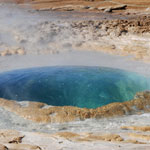
As the temperature climbs, most humans look for ways to cool down fast. But for some species of microorganisms, a midsummer heat wave isn’t nearly hot enough. These heat lovers, known as thermophiles, thrive at temperatures of 113°F or more. They’re often found in hot springs, geysers and even home water heaters.
Like humans and other organisms, thermophiles rely on proteins to maintain normal cell function. While our protein molecules break down under intense heat, a thermophile’s proteins actually work more efficiently. They also tend to be more stable at room temperature than our own. An NIH-funded research team is taking advantage of this property of thermophiles to better understand a group of human proteins commonly targeted by today’s medicines.
Read more about the team’s thermophile research in this Inside Life Science article.


Temperature reactive proteins/enzymes?
Do these proteins result in cell signaling or metabolic break down?
Do mammals have the same sequence in their genome?
The sequences of many of the proteins in thermophilic organisms are closely related to the sequences of homologues in organisms that grow at “normal” temperatures. The three-dimensional structures are very similar with a number of adjustments that are known to increase the thermal stability of the protein. As a rule of thumb, the proteins function in the expected metabolic or signalling functions, but do so at 75C rather than 37C.